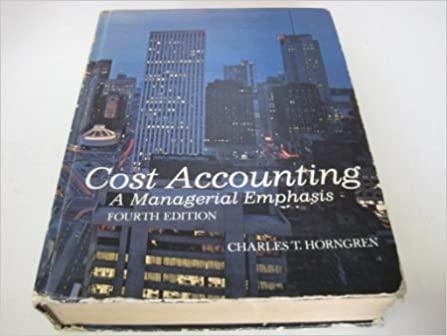Design of Management Control System; Review of Chapters 22 and 23 (Copyright 1964 by the President
Question:
Design of Management Control System; Review of Chapters 22 and 23 (Copyright © 1964 by the President and Fellows of Harvard College. Reproduced by permission.)
Empire Glass Company was a diversified company organized into several major product divisions, one of which was the glass products division. This division was responsible for manufacturing and selling glass food and beverage bottles. Each division was headed by a divisional vice-president who reported directly to the company’s executive vice-president, Landon McGregor.
Mr. McGregor’s corporate staff included three men in the financial area—
the controller, the chief accountant, and the treasurer. The controller’s department consisted of only two men—Mr. Walker and the assistant controller, Allen Newell. The market research and labor relations departments also reported in a staff capacity to Mr. McGregor.
All the product divisions were organized along similar lines. Reporting to each product division vice-president were several staff members in the customer service and product research areas. Reporting in a line capacity to each individual vice-president were also a general manager of manufacturing and a general manager of marketing. The general manager of manufacturing was responsible for all the division’s manufacturing activities. Similarly, the general manager of marketing was responsible for all the division’s marketing activities. Both these executives were assisted by a small staff of specialists. Exhibit 23-2 presents an organization chart of the glass product division’s top-management group. All the corporate and divisional management groups were located in British City, Canada. Exhibit 23-3 shows the typical organization structure of a plant within the glass products division.
The glass products division operated a number of plants in Canada producing glass food and beverage bottles. Of these products, food jars constituted the largest group, including jars for products like tomato catsup, mayonnaise, jams and jellies, honey, and soluble coffee. Milk bottles and beer and soft drink bottles were also produced in large quantities. A great variety of shapes and sizes of containers for wines, liquors, drugs, cosmetics, and chemicals were produced in smaller quantities.
Most of the thousands of different products varying in size, shape, color, and decoration were produced to order. According to British City executives, during 19_3 the typical lead time between the customer’s order and shipment from the plant was between two and three weeks.
The principal raw materials for container glass were sand, soda ash, and lime. The first step in the manufacturing process was to melt batches of these materials in furnaces or “tanks.” The molten mass was then passed into automatic or semiautomatic machines, which filled molds with the molten glass and blew the glass into the desired shape. The ware then went through an automatic annealing oven or lehr, where it was cooled slowly under carefully controlled conditions. If the glass was to be coated on the exterior to increase its resistance to abrasion and scratches, this coating—often a silicone film—was applied at the lehr. Any decorating (such as a trademark of other design) was then added, the product inspected again, and the finished goods packed in corrugated containers (or wooden cases for some bottles).
Quality inspection was critical in the manufacturing process. If the melt in the furnace was not completely free from bubbles and stones (unmelted ingredients or pieces of refinery material), or if the fabricating machinery was slightly out of adjustment, or molds were worn, the rejection rate was very high. Although a number of machines were used in the inspection process, including electric eyes, much of the inspection was still visual.
Although glassmaking was one of the oldest arts, and bottles and jars had been machine molded at relatively high speed for over half a century, the glass products division had spent substantial sums each year to modernize its equipment. These improvements had greatly increased the speed of operations and had substantially reduced the visual inspection and manual handling of glassware.
Most of the jobs were relatively unskilled and highly repetitive, and gave the worker little control over work methods or pace. The moldmakers who made and repaired the molds, the machine repairmen, and those who made the equipment setup changes between different products were considered to be the highest classes of skilled workers. Wages were relatively high in the glass industry. Production employees belonged to two national unions, and for.
Step by Step Answer:






